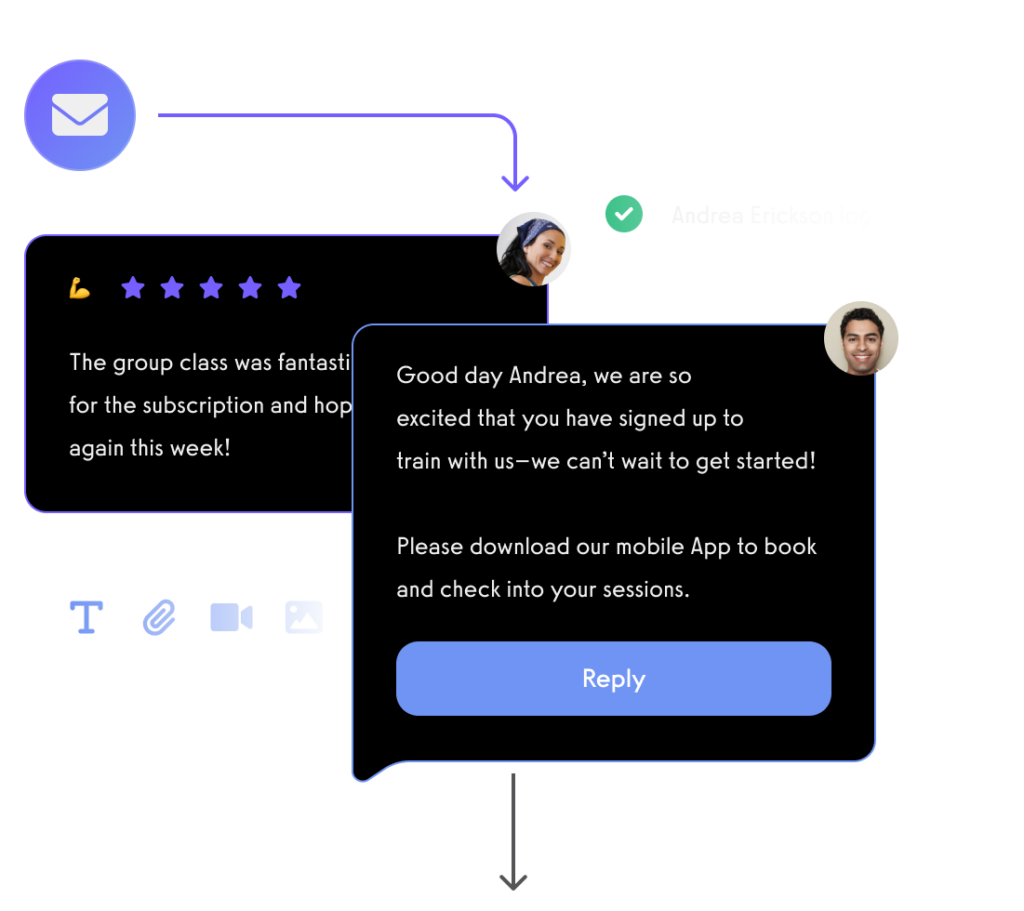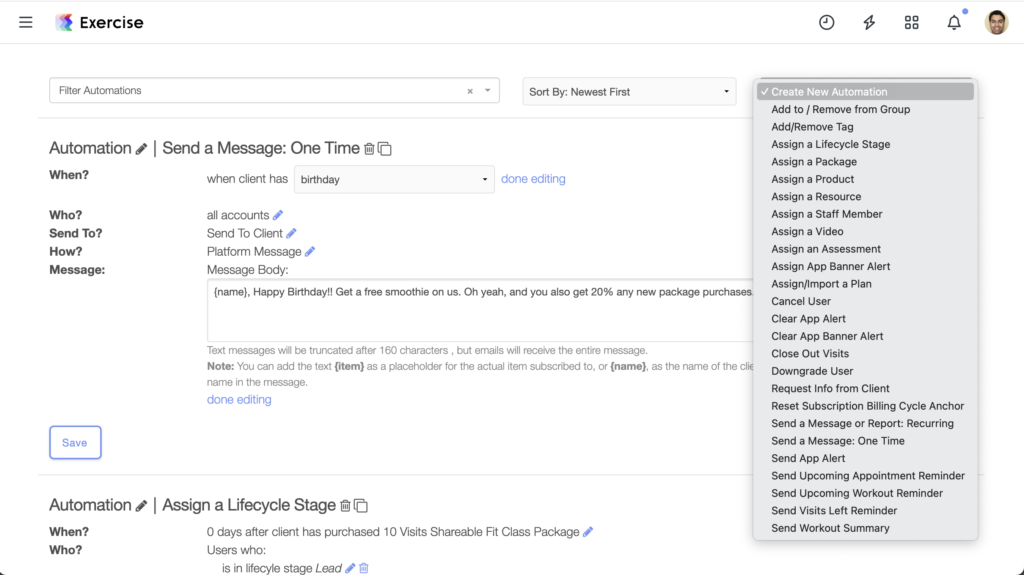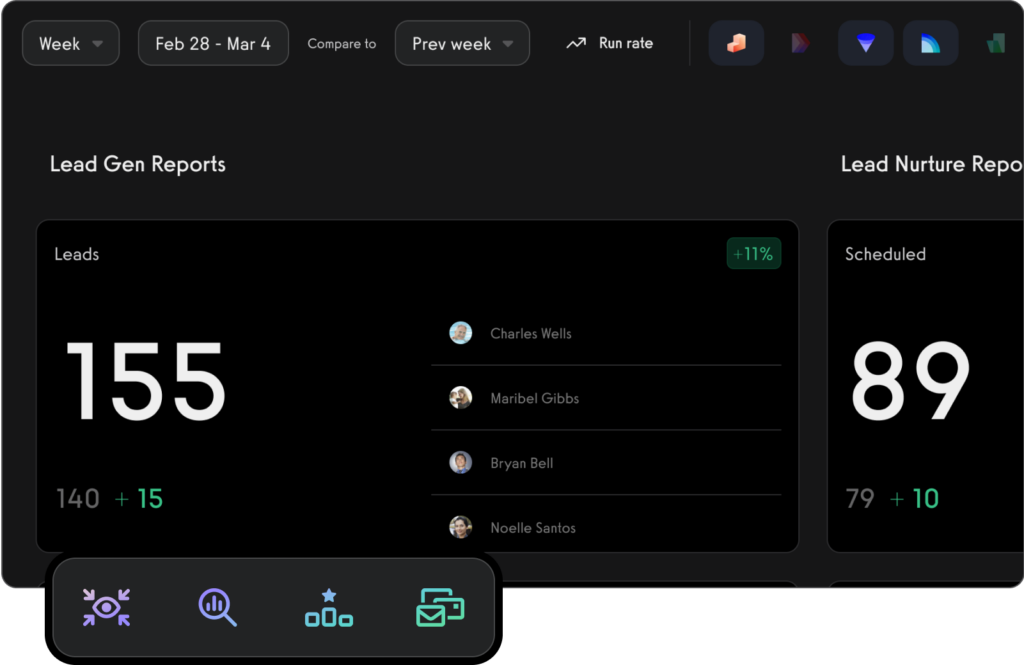Personal Trainer Marketing Plan Template (FREE)
Use this free personal trainer marketing plan template to learn how to create a personal trainer marketing plan that gets results.

Effective personal trainer marketing is essential for personal trainers to stand out from the crowd and attract clients. It’s not enough to simply be a skilled trainer; you must also have a solid marketing PT strategy in place to showcase your expertise and build a strong client base. Get a free personal trainer marketing template and personal trainer business plan template now.
In this article, we will delve into the various aspects of personal trainer marketing and provide you with a comprehensive personal training marketing template to help you succeed in this demanding field. A well-structured marketing plan template for personal trainers is essential for growing a successful fitness business, attracting new clients, and retaining current ones.
A strong marketing kit for personal trainers should include branding materials, social media templates, referral program ideas, and promotional strategies to increase visibility. Whether you’re just starting out or looking to scale your business, Exercise.com provides the best tools for marketing for fitness professionals, offering automated client management, lead tracking, and integrated marketing features.

And, of course, managing your fitness business with the best gym management software and the best personal training software that has the best marketing software for personal trainers all-in-one means that you can easily create a personal training marketing plan and then put it into action with email, SMS, and in-app messaging marketing cadences, you can create fitness session plans, waivers, forms, fitness assessments, lead forms, registration forms, offer online booking, workout plans, and much more.
Use the Exercise.com workout plan creator to create your workout plans and fitness assessments.

Publish your custom branded fitness apps to iOS and Android so you can offer a premium experience to your community.

Run fitness challenges, create online workout groups, do distance training, and of course, deliver fitness assessments and workouts, all right within the Exercise.com platform (custom branded to your brand).

See why Exercise.com is the best marketing software for gyms and fitness businesses, and how you can run your entire fitness business in one place.
Send gym and fitness marketing automations: email, SMS, and in-app.

Schedule your fitness client journey.

Use the gym CRM for lead management and fitness retention marketing.

All from your own custom branded fitness apps.


Personal Trainer Marketing Plan Template
Business Name: [Your Business or Your Name Personal Training]
Date: [Date]
Prepared by: [Your Name]
Executive Summary
Business Overview:
Briefly describe your personal training business, including your unique selling proposition, target market, and services offered.
Marketing Objectives:
State your specific marketing goals (e.g., increase client base by 20%, improve social media engagement, establish partnerships with local businesses).
Market Analysis
Target Market:
- Define your ideal client (e.g., demographics, fitness levels, goals).
- Explain their needs and how your services meet those needs.
Competitor Analysis:
- Identify local and online competitors.
- Assess their strengths and weaknesses.
SWOT Analysis:
- Conduct a SWOT (Strengths, Weaknesses, Opportunities, Threats) analysis for your business.
Marketing Strategies
Branding:
- Develop a strong brand identity (logo, colors, tone of voice).
- Ensure consistency across all marketing channels.
Service Offerings:
- Clearly define your training packages and pricing.
- Highlight any unique services or specialties.
Online Presence:
- Website: Ensure your website is user-friendly, mobile-responsive, and SEO-optimized.
- Social Media: Identify which platforms your target audience uses and develop a content plan.
Content Marketing:
- Create valuable content (blog posts, videos, infographics) that addresses client pain points.
- Utilize gym SEO best practices to increase visibility.
Email Marketing:
- Build an email list through lead magnets.
- Send regular newsletters with fitness tips, success stories, and promotional offers.
Referral Program:
- Implement a referral program with incentives for clients who refer new business.
Partnerships and Networking:
- Establish relationships with local businesses, health professionals, and community organizations.
- Attend networking events and fitness expos.
Advertising:
- Consider targeted online advertising (e.g., Facebook, Google Ads).
- Explore local advertising opportunities (e.g., flyers, local events).
Budget
- Allocate your marketing budget across different channels.
- Include costs for marketing materials, advertising, website maintenance, and any outsourcing expenses.
Action Plan and Timeline
- Break down your marketing strategies into actionable steps.
- Create a timeline for implementation, ensuring regular review and adjustments.
Monitoring and Evaluation
- Set up systems to track the effectiveness of marketing efforts (e.g., Google Analytics, social media insights).
- Regularly review and adjust your plan based on performance data.
Conclusion
Summarize your marketing plan and express confidence in its success.
This Personal Trainer Marketing Plan Template provides a structured approach to promoting your services and expanding your client base. It covers in-depth analysis, strategic planning, budget allocation, and monitoring, ensuring a comprehensive approach to marketing your personal training business. Tailor this plan to suit your unique brand and market to effectively reach and engage your target audience.
For trainers wondering how to advertise as a personal trainer, a combination of digital marketing, word-of-mouth referrals, and in-person networking is key. With Exercise.com, personal trainers can manage personal trainer advertising campaigns, create promotional offers, and run automated email marketing to keep clients engaged. Additionally, a solid personal training business plan template helps trainers outline business goals, pricing structures, and service offerings. Exercise.com also provides a personal trainer business plan template free, ensuring trainers have a clear roadmap to success. Whether you’re looking for personal training advertising strategies or need a complete personal trainer business plan, Exercise.com’s all-in-one platform helps fitness professionals execute and track their marketing efforts effortlessly.
Ready to put your personal training marketing plan into action with the best personal training software?

Why Marketing is Essential for Personal Trainers
Looking to boost your personal training business? This comprehensive personal trainer marketing template has everything you need to create an effective marketing strategy to get more PT clients.
Marketing plays a pivotal role in the success of any personal training business. Without proper marketing efforts, it becomes challenging to reach your target audience and communicate the unique value you offer as a personal trainer. By implementing effective marketing strategies, you can increase your visibility, build credibility, and ultimately attract more clients to achieve your business goals.
One of the key benefits of marketing for personal trainers is the ability to differentiate yourself from the competition. In a saturated market, it’s crucial to stand out and showcase what sets you apart from other trainers. Through marketing, you can highlight your specialized training techniques, certifications, success stories, and unique approach to fitness. This differentiation not only helps you attract clients but also positions you as an expert in your field.
Understanding Your Target Audience
Before diving into marketing strategies, it is crucial to have a deep understanding of your target audience. Knowing who your ideal clients are will help you tailor your messaging and offerings to meet their specific needs. Conduct thorough market research to understand their demographics, interests, and pain points. By empathizing with your target audience, you can create compelling marketing materials that resonate with them on a personal level.
Furthermore, understanding your target audience allows you to identify the most effective channels to reach them. Different demographics and interest groups may prefer different communication platforms, such as social media, email marketing, or traditional advertising. By knowing where your target audience spends their time, you can allocate your marketing resources more efficiently and effectively.
Identifying Your Unique Selling Proposition
In a saturated market, it is crucial to identify your unique selling proposition (USP) that sets you apart from other personal trainers. Determine what makes you special and differentiates you from your competitors. It could be your specialized expertise in a particular training technique, your success stories, or your ability to provide personalized attention to each client. Highlighting your USP in your marketing efforts will attract clients who align with your unique offerings.
One effective way to identify your USP is to conduct market research and analyze your target audience. Understanding the needs, preferences, and pain points of your potential clients will help you tailor your USP to meet their specific demands. By addressing their unique challenges and offering solutions that resonate with them, you can position yourself as the go-to personal trainer in your niche.
Another aspect to consider when defining your USP is your brand personality. Your brand should reflect your values, mission, and vision as a personal trainer. Whether you want to be seen as a motivational coach, a results-driven expert, or a compassionate mentor, aligning your USP with your brand personality will create a consistent and authentic image that attracts clients who resonate with your style.
Creating a Strong Personal Brand
Your personal brand is how you present yourself to the world as a personal trainer. It encompasses your values, personality, and the image you want to portray. Build a strong personal brand by crafting a compelling brand story, creating a professional logo and website, and maintaining a consistent social media presence. By cultivating a strong and authentic personal brand, you will establish trust and credibility with your audience.
In addition to crafting a compelling brand story, creating a professional logo and website, and maintaining a consistent social media presence, another important aspect of building a strong personal brand as a personal trainer is to consistently deliver high-quality content. This can include sharing informative articles, posting instructional videos, and providing valuable tips and advice to your audience. By consistently delivering valuable content, you will position yourself as an expert in your field and further establish trust and credibility with your audience.
Developing an Effective Marketing Strategy
A successful marketing strategy requires careful planning and execution. Start by setting clear and realistic goals for your marketing efforts. Then, consider which marketing channels are most effective in reaching your target audience. This could include social media platforms, search engine optimization (SEO), email marketing, and offline tactics such as networking and collaborations. Develop a comprehensive marketing plan that encompasses these channels and outlines specific tactics to achieve your goals.
Once you have developed your marketing plan, it is important to regularly monitor and analyze the performance of your marketing efforts. This will allow you to identify what is working well and what may need adjustments. Use analytics tools to track key metrics such as website traffic, conversion rates, and engagement on social media. Based on these insights, make data-driven decisions to optimize your marketing strategy and allocate resources effectively.
Utilizing Social Media Platforms for Promotion
Social media has become an integral part of our lives and an indispensable marketing tool. Identify the platforms where your target audience spends their time and establish a presence there. Share valuable content, engage with your audience, and showcase your expertise through videos, testimonials, and success stories. Use social media advertising to expand your reach and target specific demographics. Regularly analyze your social media performance and adjust your strategy accordingly to maximize its impact.
In addition to the above strategies, it is important to stay up-to-date with the latest trends and features on social media platforms. For example, Instagram Stories and Facebook Live have gained popularity in recent years, providing businesses with new opportunities to connect with their audience in real-time. By utilizing these features, you can create a sense of urgency and exclusivity, encouraging your followers to engage with your content and stay connected with your brand.
Read More:
Harnessing the Power of Content Marketing
Content marketing involves creating and sharing valuable and educational content to attract and engage your target audience. Use various formats such as blog posts, videos, podcasts, and infographics to educate and inspire your audience. By consistently delivering high-quality content, you position yourself as a trusted authority in your field and build a loyal following. Additionally, optimize your content for search engines to increase its visibility and attract organic traffic to your website.
One key aspect of content marketing is understanding your target audience and tailoring your content to their needs and interests. Conduct thorough research to identify their pain points, challenges, and preferences. This will help you create content that resonates with them and provides solutions to their problems. By addressing their specific needs, you can establish a deeper connection with your audience and increase the effectiveness of your content marketing efforts.
Building an Engaging Website and Optimizing for Search Engines
Your website is your online storefront and serves as a hub for all your marketing efforts. Design a visually appealing and user-friendly website that reflects your personal brand and offers a seamless browsing experience. Optimize your website for search engines by conducting keyword research and incorporating relevant keywords into your content and meta tags. Regularly update your website with fresh content, testimonials, and success stories to keep it engaging and persuasive.
In addition to optimizing your website for search engines, it is also important to focus on creating high-quality, valuable content. This includes writing informative blog posts, creating engaging videos, and offering downloadable resources such as e-books or whitepapers. By providing valuable content, you not only attract more visitors to your website but also establish yourself as an authority in your industry. Remember to promote your content through social media channels and encourage your audience to share it with others, further increasing your website’s visibility and reach.
Read More:
Implementing Email Marketing Campaigns to Reach Clients
Email marketing remains one of the most effective ways to nurture relationships with prospects and convert them into clients. Collect email addresses through your website and in-person interactions, and segment your list based on client preferences and interests. Develop targeted email campaigns that deliver valuable content, exclusive offers, and updates tailored to each segment. Personalize your emails to make each recipient feel valued, and track open rates and click-through rates to gauge the effectiveness of your campaigns.
In addition to personalizing your emails, it is important to regularly analyze and optimize your email marketing campaigns. Use A/B testing to experiment with different subject lines, email designs, and call-to-action buttons to determine what resonates best with your audience. Monitor your email deliverability and ensure that your emails are reaching the intended recipients’ inboxes. Continuously refine your email content and strategy based on the insights gained from your analytics to maximize the impact of your email marketing efforts.
Leveraging Online Reviews and Testimonials for Credibility
Positive online reviews and testimonials can significantly impact your reputation and credibility as a personal trainer. Encourage your satisfied clients to leave reviews on popular review platforms such as Google, Yelp, and Facebook. Showcase these reviews prominently on your website and social media channels. Additionally, consider creating video testimonials where clients can share their success stories and how you have helped them achieve their fitness goals. These authentic testimonials will inspire trust in prospective clients and motivate them to choose you as their personal trainer.
Furthermore, it is important to respond to both positive and negative reviews in a timely and professional manner. Thank your clients for their positive feedback and address any concerns or issues raised in negative reviews. This shows that you value your clients’ opinions and are committed to providing excellent service. By actively engaging with online reviews, you can further enhance your credibility and build a positive reputation in the fitness industry.
Networking and Collaborating with other Fitness Professionals
Collaborating with other fitness professionals can open doors to new opportunities and expand your client base. Attend industry events, workshops, and conferences to network with fellow professionals and build meaningful relationships. Explore partnerships with complementary businesses such as nutritionists, yoga studios, or physical therapists. By leveraging these collaborations, you can cross-promote each other’s services and tap into new client segments.
Another way to network and collaborate with other fitness professionals is through online platforms and social media. Join fitness-related groups and communities on platforms like LinkedIn, Facebook, or Instagram. Engage in discussions, share your expertise, and connect with like-minded professionals. This virtual networking can lead to valuable collaborations, joint projects, and even referrals from other professionals in the industry.
Additionally, consider joining professional associations or organizations specific to your fitness niche. These associations often host networking events, provide educational resources, and offer opportunities to connect with industry leaders. By becoming an active member, you can stay updated on the latest trends, gain access to exclusive networking opportunities, and establish yourself as a trusted professional within your niche.
Hosting Workshops and Events to Showcase Expertise
Hosting workshops and events is an excellent way to position yourself as an expert in your field and attract potential clients. Identify topics that align with your target audience’s interests and organize informative and engaging workshops. Utilize your online and offline marketing channels to promote these events and generate buzz. Providing valuable content and actionable takeaways during these workshops will leave a lasting impression on attendees and increase the likelihood of them becoming your clients.
Maximizing Referrals and Word-of-Mouth Advertising
Word-of-mouth advertising is a powerful marketing tool that can lead to exponential growth for your personal training business. Delight your existing clients with exceptional service and results, and encourage them to refer their friends, family, and colleagues. Implement a referral program that rewards clients for each referral that converts into a paying customer. Offer incentives such as discounted sessions or exclusive access to special events to motivate clients to spread the word about your services.
Read More:
Tracking and Analyzing Marketing Efforts for Optimal Results
To achieve optimal marketing results, it is crucial to track and analyze the performance of your marketing efforts. Utilize analytics tools, such as Google Analytics, to gather data on website traffic, conversion rates, and user behavior. Review the effectiveness of your social media campaigns, email marketing campaigns, and other marketing initiatives. Based on these insights, make data-driven decisions to optimize your marketing strategies and allocate resources to the most effective channels.
By following this comprehensive personal trainer marketing template and leveraging the power of various marketing strategies, you can attract a steady stream of clients and grow your personal training business. Remember, marketing is an ongoing process, and it requires consistent effort and adaptation to stay ahead of the competition. Stay committed to delivering exceptional results, providing value to your clients, and continuously refining your marketing approach to achieve long-term success in the dynamic fitness industry.
How do you market a personal trainer?
To market a personal trainer, use a combination of online and offline strategies. Online, leverage social media, a professional website, and email marketing. Offline, consider local partnerships, community events, and referrals. Showcase your expertise, client testimonials, and unique training style.
How do you write a business plan for a PT?
When writing a business plan for a personal trainer, include an executive summary, market analysis, business structure, services offered, marketing and sales strategies, financial projections, and an operational plan. Clearly define your target market, competition, and unique selling propositions.
How do I brand myself as a personal trainer?
To brand yourself as a personal trainer, identify your unique training style, values, and what sets you apart. Develop a brand identity (logo, color scheme) and consistent messaging across your marketing materials and online presence. Build a strong personal brand that resonates with your target audience.
How do I make a personal trainer marketing plan?
To make a personal trainer marketing plan, start by identifying your target market and unique selling points. Set marketing goals, choose the right channels (social media, email, etc.), create engaging content, and plan promotional activities. Regularly review and adjust your strategy based on performance.
How many clients is a lot for a personal trainer?
A lot for a personal trainer typically ranges from 15-25 clients per week, depending on the training session’s length and the trainer’s capacity to provide quality services. Balancing quantity with the ability to deliver personalized attention is key.
How do I get new clients for personal training?
To get new clients for personal training, utilize social media marketing, network within your community, offer referral incentives, collaborate with local businesses, and maintain an active online presence with engaging content. Always provide excellent service to encourage word-of-mouth referrals.
What makes a personal trainer stand out?
A personal trainer stands out by offering a unique training approach, specializing in certain areas (like weight loss, rehabilitation, sports-specific training), demonstrating genuine care for clients’ progress, and maintaining high professional standards. Building a strong personal brand and being relatable also helps.
Do personal trainers need marketing?
Yes, personal trainers need marketing to attract and retain clients, build brand awareness, and stand out in a competitive market. Effective marketing helps to communicate the trainer’s expertise, success stories, and the unique benefits of their training services.
How can Exercise.com help me run my fitness business?
Exercise.com can help run your fitness business by offering a comprehensive software platform tailored for fitness professionals. Its features include client and schedule management, workout creation and delivery, progress tracking, billing, and business reporting. The platform streamlines administrative tasks, enhances client engagement, and provides tools for effective marketing and business growth.












